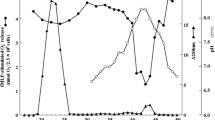Abstract
Polymorphonuclear leukocytes isolated from endotoxin pretreated (0.1 mg/kg 24 hours before) guinea pigs are shown to be hypersensitive and hyperresponsive to the formylated bacterial chemoattractant FMLPin vitro. Dose-response curves for chemiluminescence and β-glucuronidase release are shifted to the left and maxima are increased. In receptor binding studies the FMLP binding capacity is shown to be enhanced in cells from endotoxin pretreated animals. FMLP (0.3 mg/kg) administered intravenously into anaesthetized and artificially ventilated guinea pigs is shown to induce neutropenia and a biphasic rise of the insufflation pressure. This response is exaggerated in endotoxin pretreated animals. The initial elevation of the airway resistance is cyclooxygenase dependent, whereas the following rise is cyclooxygenase independent and parallels the neutropenia. Histologically PMN's are shown to be trapped in the pulmonary capillaries. This is associated with an intraseptal/interstitial edema. The results illustrate a functional synergism between two important bacterial products, endotoxin and FMLP.
Similar content being viewed by others
References
H. J. Showell, R. J. Freer, S. H. Zigmond, E. Schiffman, S. Aswanikumar, B. Corcoran and E. L. Becker,The structure activity relations of synthetic peptides as chemotactic factors and inducers of lysosomal enzyme secretion for neutrophils. J. Exp. Med.143, 1154–1169 (1976).
L. A. Sklar, P. A. Hyslop, Z. G. Oades, G. M. Omann, A. J. Jesaitis, R. G. Painter and C. G. Cochrane,Signal transduction and ligand-receptor dynamics in the human neutrophil. Transient responses and occupancy-response relations at the formyl peptide receptor. J. Biol. Chem.260, 11461–11467 (1985).
J. Palmblad, H. Gyllenhammar, J. Å. Lindgren and C. L. Malmsten,Effects of leukotrienes and F-Met-Leu-Phe on oxidative metabolism of neutrophils and eosinophils. J. Immunol.132, 3041–3045 (1984).
R. M. Palmer and J. A. Salmon,Release of leukotriene B 4 from human neutrophils and its relationship to degranulation induced by N-formyl-methionyl-leucyl-phenylalanine, serum treated zymosan and ionophore A23187. Immunology50, 65–77 (1983).
Y. Morita, P. K. Chiang and R. P. Siraganian,Effect of inhibitors of transmethylation on histamine release from human basophils. Biochem. Pharmacol.30, 785–791 (1981).
A. C. Issekutz,Vascular responses during acute neutrophilic inflammation. Their relationship to in vivo neutrophil emigration. Lab. Invest.45, 435–441 (1981).
N. Berend, C. L. Armour and J. L. Black,Formyl-methionyl-leucyl-phenylalanine causes bronchocontriction in rabbits. Agents and Actions17, 466–471 (1986).
V. Desai, D. L. Kreutzer, H. Showell, C. V. Arroyave and P. A. Ward,Acute inflammatory pulmonary reactions induced by chemotactic factors. Am. J. Pathol.96, 71–83 (1979).
R. B. Gilbertsen, G. W. Carter and D. J. Quinn,Effects of F-Met-Leu-Phe and zymosan-activated serum on rat neutrophils in vivo. J. Reticuloendoth. Soc.27, 485–494 (1980).
J. Fehr, C. Dahinden and R. Russi,Formylated chemotactic peptides can mimic the secondary, provoking endotoxin injection in the generalized Shwartzman reaction. J. Infect. Dis.150, 160–161 (1984).
U. B. Olsen and V. Bille-Hansen,Exaggerated hypotension by N-formylmethionylleucylphenylalanine in indomethacin pretreated rats. Role of toxic oxygen. Agents and Actions17, 489–494 (1986).
P. Hamel, A. W. Ford-Hutchinson, A. Lord and M. Cirimo,Bronchoconstriction induced by N-formyl-methionyl-leucylphenylalanine in guinea pig; involvement of archidonic acid metabolites. Prostaglandins28, 43–56 (1984).
M. A. Trush, M. E. Wilson and K. V. Kyke,The generation of chemiluminescence by phagocytic cells. In:Methods in enzymology. Bioluminescence and chemiluminescence, Vol. 57, pp. 462–468 (Ed. M. A. DeLuca). Academic Press 1978.
P. D. Stahl and O. Touster,β-glucuronidase of rat liver lysosomes. Purification, properties subunits. J. Biol. Chem.246, 5398–5403 (1971).
H. Nunai, F. Endo, S. Chikazawa and I. Matsuda,Regulation of receptors and digestive activity toward synthesized formyl-chemotactic peptide in human polymorphonuclear leukocytes. Blood66, 106–114 (1985).
M. P. Fletcher and J. I. Gallin,Degranulating stimuli increase the availability of receptors on human neutrophils for the chemoattractant F-Met-Leu-Phe. J. Immunol.124, 1585–1588 (1980).
M. P. Fletcher, B. E. Seligmann and J. I. Gallin,Correlation of human neutrophil secretion, chemoattractant receptor mobilization and enhanced functional capacity. J. Immunol.128, 941–948 (1982).
J. T. Rosenbaum, K. T. Hartiala, R. O. Webster, E. L. Howes and I. M. Goldstein,Anti inflammatory effects of endotoxin. Inhibition of rabbit polymorphonuclear leukocyte responses to complement (C5)-derived peptides in vivo and in vitro. Am. J. Pathol.113, 291–299 (1983).
P. K. Tsung, H. J. Showell and E. L. Becker,Surface membrane enzyme, chemotactic peptide binding activities, and chemotactic responsiveness of rabbit peripheral and peritoneal neutrophils. Inflammation4, 271–277 (1980).
W. Zimmerli, B. Seligmann and J. I. Gallin,Exudation primes human and guinea pig neutrophils for subsequent responsiveness to the chemotactic peptide N-for-mylmethionylleucylphenylalanine and increases complement component C3 bi receptor expression. J. Clin. Invest.77, 925–933 (1986).
E. W. Spanhake, J. L. Colombo, P. A. Craigo, D. B. McNamara, A. L. Hyman and P. J. Kadowitz,Evidence for modification of pulmonary cyclooxygenase activity by endotoxin in the dog. J. Appl. Physiol.54, 191–198 (1983).
P. M. Henson, G. L. Larsen, R. O. Webster, B. C. Mitchell, A. J. Goins and J. E. Henson,Pulmonary microvascular alterations and injury induced by complement fragments: Synergistic effect of complement activation, neutrophil sequestration and prostaglandins. Ann. N.Y. Acad. Sci.384, 287–300 (1985).
Author information
Authors and Affiliations
Rights and permissions
About this article
Cite this article
Olsen, U.B., Bille-Hansen, V. Endotoxin pretreatment enhances neutrophil FMLP-receptor binding and activity in guinea pigs. Agents and Actions 21, 177–183 (1987). https://doi.org/10.1007/BF01974939
Received:
Accepted:
Issue Date:
DOI: https://doi.org/10.1007/BF01974939



